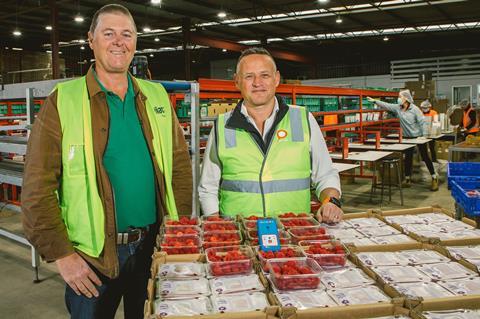Leading fruit producer says use of Escavox smart trackers has given it much greater assurance in quality and integrity of shipments
Four years after major fruit producer Piñata Farms introduced Australian-designed technology to track the temperature and location of premium berries and mangoes along the supply chain, it has “more confidence than ever” in the quality and integrity of fruit despatched, according to a media release from the company.

Queensland-headquartered Piñata Farms began working with supply chain specialist Escavox in 2019 to initially measure the temperature of berries throughout the supply chain via smart trackers so it could secure visibility of fruit at any given time.
“This was information previously unavailable to us. We now have smart trackers in every berry consignment leaving our main packing operation at Wamuran, southeast Queensland and every mango load leaving three farms in the Northern Territory during mango season,” said Piñata Farms’ managing director Gavin Scurr.
“We have gained complete visibility over our consignments and can effectively share this information with customers at any time. We could have 30-40 consignments on the road right across Australia at any time and need to know that temperature has been maintained throughout and that the consignment is on time to meet delivery timeslots.
“The system gives us transparency and eliminates innuendo. If there’s product loss, the system provides an indisputable record of what has happened and who is liable.”
Promoting accountability
Piñata Farms has achieved two main benefits since implementing the Escavox system, according to Scurr, the first being stakeholder accountability.
“Now that everyone along the supply chain (including drivers and distribution and ripening centre personnel) knows the temperature is being monitored, they try harder to get it right. It puts accountability into the hands of all involved in getting fruit to the shelf. There’s now a sharp focus on temperature.”
Temperature information includes whether produce is too hot, too cold or exposed to too much light, humidity or movement, based on what the category requires to retain optimal quality and freshness.
If the temperature was compromised for any reason (such as truck breakdown or equipment malfunction), drivers could take action to rectify the situation, Scurr said.
Real-time location tracking
The second major benefit stems from the system’s Escavox GPS function, which enables Piñata Farms to tell where loads are located at any time, noted Scurr
“If a consignment is running late, due to the many variables that can happen on Australian roads, we can tell our customers exactly where the load is and its estimated time of arrival,” he said. “This is key when distribution centres operate in 10-minute timeslots. Previously, we’d contact the freight provider, who’d track down the driver and get back to us with the location, which we’d then communicate with the customer. Now, we can see in real time, where the truck is and share the information in an instant.
“It makes our supply chain processes more efficient. The trackers ensure we have an improved chance of delivering optimal quality of fruit, every time.”
Greater assurance for specific categories
Scurr said Piñata Farms used the Escavox system in berries and mangoes because both were highly perishable lines with specific, critical cool chain needs.
The devices, about the size of a mobile phone, are placed by Piñata Farms in a carton or container on loading and are retrieved by Escavox for reuse after the consignment’s arrival.
Escavox founder and chief executive officer Luke Wood said the ability for Piñata Farms to see its supply chain in real time allowed “simple” solutions such as rejections and handling errors to be fixed quickly.
“We give suppliers the information they need to improve their supply chains. Our data tells them why things might be going wrong or going well so they can take the best action. Over time the data becomes an operating model that gives producers confidence to move towards more strategic investment such as developing cool-room technology and key partnerships along the supply chain,” Wood said.



